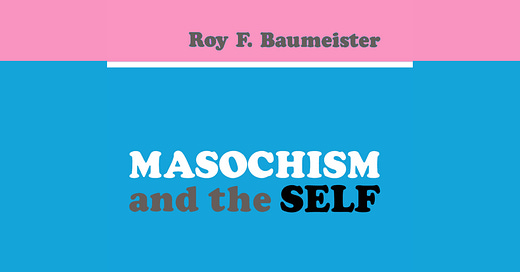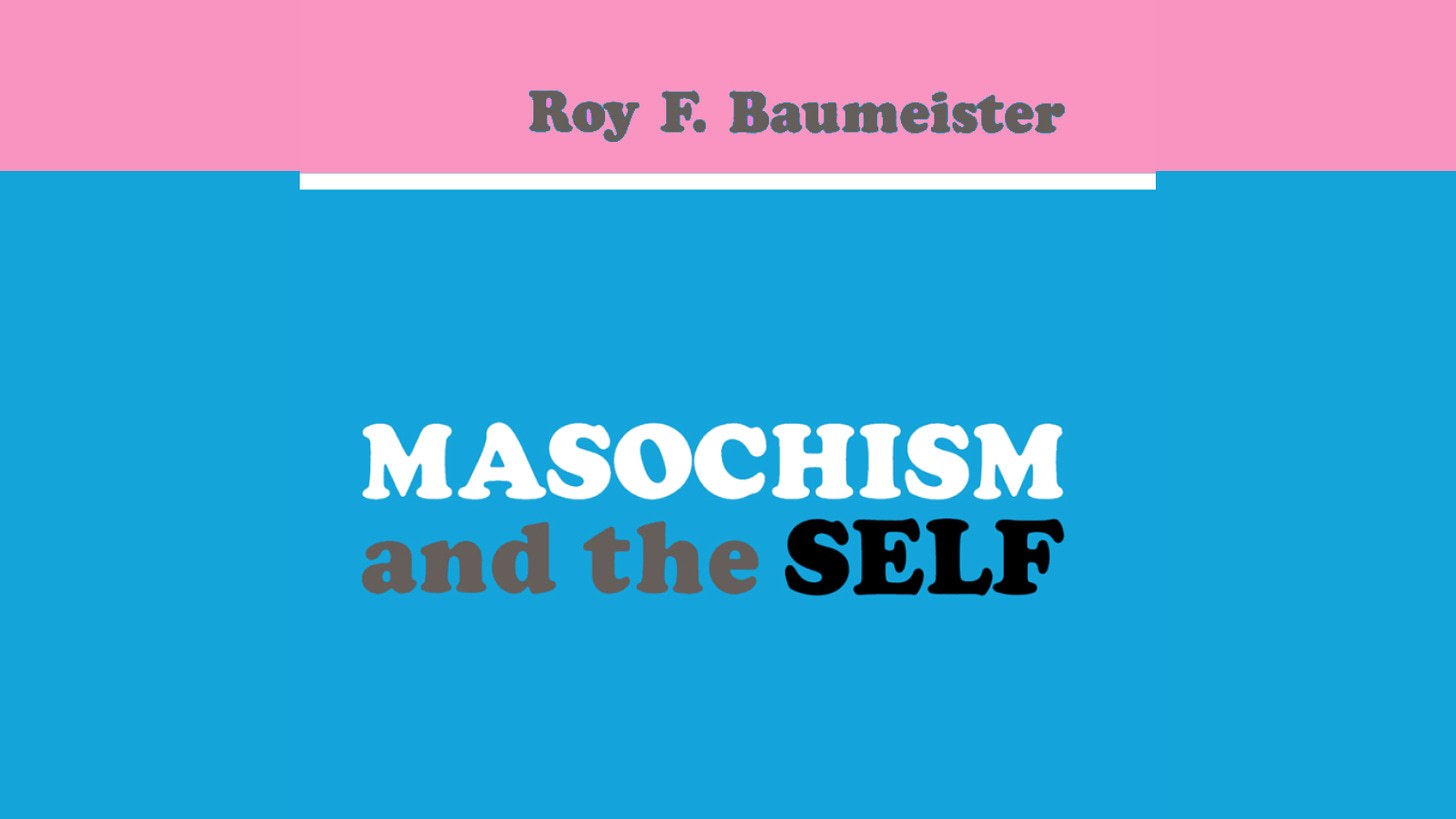“Masochism deconstructs the self, providing escape from identity into body… It provides a powerful escape from self, in the sense of removing the person’s typical awareness of his or her normal identity. Once this is cleared away, however, masochism sometimes celebrates a new, fantasy identity in its place. The escape from self is thus completed by becoming someone else. Identity is not merely removed from awareness but transformed.”
Professor Roy F. Baumeister is a social psychologist who is known for his work on the self, social rejection, belongingness, sexuality and sex differences, self-control, and free will. His 1989 book Masochism and the Self explains the phenomena of sexual masochism as a means of releasing the individual from the burden of self-awareness.
In Chapter 7, “Femininity, Masculinity, and Masochism”, Baumeister discusses the aspect of gender in sexually masochistic practices. He found that in men, masochism presents differently than in women, with male masochists often eroticizing humiliation and the loss of status, including being “symbolically converted into women” and that “the desire for loss of status is a central feature of male masochism.”
According to Baumeister, male masochists masturbate more frequently as compared with other men. He also found that they take pride in the amount of pain they can endure, with suffering being conflated with strength. The male masochists are frequently interested in having spectators and desire audience participation in their fetishes.
Baumeister’s reflections on gender stereotypes, masochism, and transvestism can be applied in the context of gender identity ideology today, a movement which originated from male sexual fetishes and practices but has been normalized through audience participation: specifically, the inclusion of women and children. The overwhelming majority of those claiming a ‘gender identity’ in the past were middle-aged men with an affinity for transvestism.
The social construction of the ‘trans youth’ or ‘trans child’ represents a projection of the male fetishist, who desires earlier transition for himself, believing if he had had access to such interventions, it would have made him more sexually attractive.
Understanding gender identity ideology as a male masochistic fetish serves to explain why it is that transactivists insist that trans-identifying males are the most oppressed and marginalized women. The repetitive claims to subordination serve to validate their masochistic desires, while at the same time erasing actual violence against women. Statistics regarding the murders of trans-identifying males that are used internationally by lobbying organizations are largely from Brazil, where sex trafficking flourishes and thrives off the exploitation of women, but also targets trans-identifying men, promising it will fund their ‘feminization’ surgeries and hormones.
According to a study conducted in 2019, 90 percent of trans-identified men in Brazil are in the commercial sex industry. Some research suggests women trafficked in the sex industry are 60 - 100 times more likely to be killed. When men claim a female identity and engage in prostitution, they are typically not doing so to feed their children; in some instances, they may be seeking to validate a masochistic fetish.
Regardless, gender activists hijack women’s oppression, arguing that murders of trans-identified males which overwhelmingly occur in the context of sex trafficking entitle them to ‘feminization’, or the fulfillment of their fetish, as health care on demand — as well as justify the full decriminalization of sex trafficking.
A sexualized masochistic tendency among males is currently being re-branded as a full-time experience and normalized as innate through gender identity ideology. This sexual fetish is being used to rationalize removing boundaries and rights from women and girls. This masochistic desire is even being used to rationalize the chemical castration of children. It is not a coincidence that this movement sprang up alongside streaming pornography and a worldwide feminist movement that began harnessing social media to call for greater accountability for male violence.
Male masochists have found a powerful new identity in the misappropriation of womanhood, and this theft paves the way for their success in the fields of pornography, public speaking, activism, publishing, and academia. Through gender identity ideology, men fetishize degradation, humiliation, status loss — which is to say, these male masochists are aroused by the systemic oppression of the female sex.
Excerpts from “Masochism and the Self”:
“Some male masochists desire to be symbolically converted into women. To them, masochistic satisfaction includes dressing and acting as a woman.
Gender switching is exclusively associated with male masochism. Usually this took the form of being dressed up in women’s underwear. Sometimes the transvestism extended to shaving body hair, plucking eyebrows, applying lipstick and makeup, wearing a feminine wig, or wearing a dress. Some of the male masochists were given female names to use when thus attired.
Male masochists show clear behavioral signs of being feminized. In contrast, female masochists show no such signs of being masculinized. Indeed, the only references I found anywhere to dressing up among female masochists involved wearing ultra-feminine clothing. Thus, ironically, when women masochists do resort to gender symbolism in clothing, they are feminized rather than masculinized. Both male and female masochists tend to dress and act in a stereotypically feminine fashion.
Males engage in sexual masochism more than females. Male masochists are often feminized, whereas male masochists are almost never masculinized. There is some association between masochism and femininity. The submissive desires of the masochist take forms that resemble cultural ideals and stereotypes of femininity, and sometimes this resemblance makes male masochists desire explicit feminization.
When male masochists desire to be feminized, it is probably not because women are somehow masochistic. Rather, it is because the goals of masochism resemble models of femininity, including submissiveness, passivity, and self-sacrifice. The fact that women’s status has generally been lower [than] men’s status may provide part of the attraction, for male masochists seek lower status in various ways. Probably the quest for low status is not a full explanation for the male masochistic interest in feminization, however. Even when status has been lowered by other techniques, male masochists sometimes still desire feminization.
The fact that our culture’s ideals of femininity resemble the goals of masochism should not be disregarded. It is probably what confused some past theorists and observers. If feminine ideals look like masochist ideals, then a woman who conforms to feminine ideals will resemble a masochist in some respects. No doubt many women do seek to fulfill such cultural expectations, and that is probably why Freud and others mistook femininity for masochism. But the resemblance between masochistic and feminine models tells us more about our culture than about the essential nature of womanhood.
Despite the lingerie and makeup, the male transvestite masochists remained masculine masochists. Indeed, the transvestite male masochists were farther away from the female masochists than the other male masochists were. In other words, the transvestite male masochists showed more extremely masculine patterns than the other males. Male transvestite masochists resemble other male masochists; they do not resemble female masochists.
Whereas feminine masochism favors display humiliation, male masochism appears to favor status degradation. Male masochists seem to like to be reduced to beings of lesser status, such as dogs or babies. It is also noteworthy that many males reported being feminized, which also entails loss of status insofar as men generally have higher status than women. Presumably, status is a central issue in male identity, and the desire for loss of status is a central feature of male masochism.
Male masochism appears to be centrally concerned with escaping this superior status. Men describe being degraded, which removes their freedom and dignity, and they emphasize being tied up, which prevents them from exerting the power and control that normally accompany high (and male) status.
Female masochists, in contrast, generally start out already lower in status and power than their male partners. There would perhaps be little attraction to them of being degraded and constrained, for society has already done that to them for centuries. For many women, adopting an inferior role would hardly be a departure from their normal lives.
It appears that masochists desire audiences more than dominants do. Male masochists strongly favor participant audiences. Apparently, male masochists desire the presence of others in order to furnish more partners for sex or for sadomasochistic activities. Having a passive spectator who does nothing more than provide a witness seems to have little appeal for the masculine masochist.
Masculine masochism exceeded feminine masochism in severity of pain, in overall humiliation, in status loss and degrading humiliations, in oral humiliations, in partner infidelity, in active participation by audiences and third parties, and in gender switching (transvestism).
The theory of masochism as escape from high to low levels of selfhood appears best able to integrate these diverse patterns of male masochism. The symbolic aspects of the male ego (including responsibility, control, and pride) are systematically denied in masochism, thus removing the high-level aspects of the self. But the focus on sensations, which involves the lowest and most immediate levels of self, is retained and emphasized.
The man is transformed into something less than a man, through symbolic treatment as a baby, woman, or animal. His autonomy and independence are denied by tying him up, giving him commands and rules, and so forth. His maleness is abused and contradicted by ignoring his penis, by having his partner look elsewhere for sexual satisfaction, and by feminizing him.
Masochism has both constructive and deconstructive aspects. It provides a powerful escape from self, in the sense of removing the person’s typical awareness of his or her normal identity. Once this is cleared away, however, masochism sometimes elaborates a new, fantasy identity in its place. The escape from self is thus completed by becoming someone else. Identity is not merely removed from awareness but transformed.”






WOW! This is a totally KILLER piece. A classic! Looking forward to linking in future discussions with LARPers. Mic drop!
Very interesting, and makes a lot of sense. Now to get others to see it.